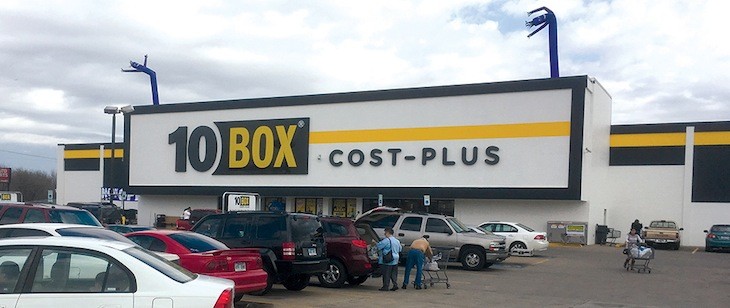Harps employs discount strategy with 10BOX concept
by March 16, 2017 1:27 pm 10,448 views

Harps Food Stores has a new retail concept that advertises all items priced “at cost,” with a flat 10% added at the register.
10BOX Cost-Plus recently opened in a former Price Cutter building at the corner of South Thompson Street and West Sunset Avenue in Harps’ hometown of Springdale. Previous locations debuted in Russellville in January and in Conway last July.
The company advertises that a price tag within a 10BOX store is indicative of how much was spent to get the item onto the shelf, and the 10% at the register goes toward running the store. The concept is based on stores seen in other states, said Harps President and CEO Kim Eskew.
During its first week open in February, the Springdale store sold, for example, boneless skinless chicken breasts for 97 cents a pound and green grapes for 88 cents per pound. An 8-ounce package of Dole Baby Spinach was $2.65, compared to $3.29 that week at Harps. Size 4 Luvs brand diapers were $14.26 for an 88-pack at 10BOX, compared to $20.98 at Harps. An 11.5-ounce bag of Snickers Easter candy was $1 cheaper at 10BOX, at $2.92. The 10BOX prices do not, however, include the 10% added cost at checkout.
The store offers a variety of name brands, in addition to generic brands like Best Choice. The idea is low cost, no frills.
“To operate with this cost-plus strategy requires us to also have the lowest cost structure possible,” Eskew said.
BREAK FROM THE HARPS NAME
10BOX stores are usually based in older buildings — former Price Cutter or Harps locations so far — with basic signage and equipment. Harps also has saved money on 10BOX by not hiring designated grocery bagging staff or offering service departments like bakeries or delis, which have high labor and supply costs.
“The stores are not fancy. All of this combined lowers our operating costs which in turn allows us to have lower gross margins,” Eskew said. “Our buyers look for deals and buy in large quantities, and we pass along the savings to our customers.”
Eskew said 10BOX has approximately the same number of items on sale as a typical Harps or Price Cutter store, but the assortments are different because “under-performing” flavors or varieties of certain products have been removed and the number of sizes offered has been reduced. Also, there are larger quantities of items, both on the sales floor in dump bins and in the back room.
The model is a departure from the Harps brand, which offers a broad range of services and “focuses on freshness and quality,” Eskew said. That’s why the company did not use Harps in the name.
“If we called it 10BOX by Harps, people would think it was another Harps store, and it’s really something completely different,” Eskew said. “Our goal in the 10BOX stores is to have the lowest prices possible.”
EDLP STRATEGY
Dr. Dinesh Gauri, professor and Walmart Chair in marketing at the University of Arkansas’ Sam M. Walton College of Business, said Harps’ entree into using an Every Day Low Pricing (EDLP) strategy could be a result of the company feeling pressure from competitors like Wal-Mart Stores and Aldi.
He pointed to a rise in the number of Walmart Neighborhood markets in recent years, in addition to bag-your-own grocery stores like Aldi, where the quality of its private label items was called into question at first but now has wide acceptance.
Harps Chairman Roger Collins said sales were down in 2016 “because of the number of Walmarts opened in our trade area.” Sales were $692 million in the fiscal year that ended in August. That’s down from $708 million in 2015 and marks the second consecutive year revenue has fallen, according to the Northwest Arkansas Business Journal’s list of private companies.
Harps reached a high in 2014 with revenue of $713 million, after increasing each year since $440 million in 2008. Collins said Harps will turn things around in 2017, with sales projected to increase about 10%.
Gauri said 10BOX could be a smart move for Harps.
“Any company has to think about how to get people in the doors,” he said, noting the various ways to do that because there are different types of people in the market.
For example, Whole Foods Market shoppers are willing to pay a premium for a certain assurance of quality and to know more about an item’s sourcing, he said. Harps is able to reach a certain segment of the population at its Harps grocery stores, where the company employs a high-low pricing strategy where items are discounted after they become less popular. Overall, Gauri said 10BOX is a “good experiment” for Harps.
Bryan Aguiar, professor of business at NorthWest Arkansas Community College, said the 10BOX concept is an easy model for the company because of the simplicity of one, flat mark-up, where there are usually a wide range of them within the average grocery store. At the same time, although Aguiar said he has not studied the 10BOX model, his “gut feeling” is that it’s not much of a deal for customers. While overall the prices are lower than Harps, they might not be lower than its other competitors. In fact, Aguiar believes the cost-plus idea is a gimmick.
“From a consumer side, I don’t really see any advantages,” he said.
Dean Payton, 10BOX district manager, disagrees. He said, “I’ve done the math and the research, and it’s really a good deal.”
The 10BOX store growth plan is uncertain. The company would like to continue to expand the concept but wants to see how the stores do, Eskew said. Harps had 85 grocery stores and 4,000 employees as of August 2016.
